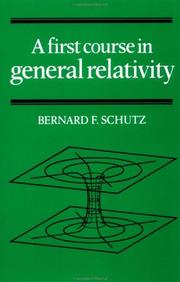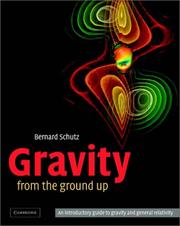| Listing 1 - 10 of 10 |
Sort by
|

ISBN: 0521232716 0521298873 9780521298872 9780521232715 9781139171540 Year: 1980 Publisher: Cambridge Cambridge University Press
Abstract | Keywords | Export | Availability | Bookmark
 Loading...
Loading...Choose an application
- Reference Manager
- EndNote
- RefWorks (Direct export to RefWorks)
Geometry, Differential --- Mathematical physics --- 514.8 --- Physical mathematics --- Physics --- Differential geometry --- 514.8 Geometric study of objects of mechanics and physics --- Geometric study of objects of mechanics and physics --- Mathematics --- Geometry, Differential. --- Mathematical physics. --- Géométrie différentielle --- Physique mathématique --- Géometrie différentielle --- Lie, Groupes de --- Géometrie différentielle --- Application a la physique
Book
ISBN: 9780521887052 Year: 2014 Publisher: Cambridge Cambridge University Press
Abstract | Keywords | Export | Availability | Bookmark
 Loading...
Loading...Choose an application
- Reference Manager
- EndNote
- RefWorks (Direct export to RefWorks)
Clarity, readability and rigor combine in the second edition of this widely-used textbook to provide the first step into general relativity for undergraduate students with a minimal background in mathematics. Topics within relativity that fascinate astrophysical researchers and students alike are covered with Schutz's characteristic ease and authority - from black holes to gravitational lenses, from pulsars to the study of the Universe as a whole. This edition now contains discoveries by astronomers that require general relativity for their explanation; a revised chapter on relativistic stars, including new information on pulsars; an entirely rewritten chapter on cosmology; and an extended, comprehensive treatment of modern detectors and expected sources. Over 300 exercises, many new to this edition, give students the confidence to work with general relativity and the necessary mathematics, whilst the informal writing style makes the subject matter easily accessible.
Theory of relativity. Unified field theory --- Relativité générale (physique) --- Astrophysique. --- General relativity (Physics). --- Astrophysics. --- General relativity (Physics) --- Astrophysics --- Relativistic astrophysics --- Astrophysique --- Astrophysique relativiste --- Study and teaching (Higher) --- Etude et enseignement (supérieur) --- Étude et enseignement (supérieur) --- Relativité générale (physique) --- Étude et enseignement (supérieur)

ISBN: 0521277035 9780521277037 0521257700 9780521257701 Year: 1990 Publisher: Cambridge Cambridge University Press
Abstract | Keywords | Export | Availability | Bookmark
 Loading...
Loading...Choose an application
- Reference Manager
- EndNote
- RefWorks (Direct export to RefWorks)

ISBN: 110715717X 1139635875 9786612389443 1282389440 0511644698 0511807805 0511648693 0511336314 0511555512 0511336969 9780511648694 9780511336966 9780511251900 0511251904 9780511807800 9781282389441 0521455065 9780521455060 9781139635875 6612389443 9780511644696 9780511336317 9780511555510 Year: 2003 Publisher: Cambridge New York Cambridge University Press
Abstract | Keywords | Export | Availability | Bookmark
 Loading...
Loading...Choose an application
- Reference Manager
- EndNote
- RefWorks (Direct export to RefWorks)
This book invites the reader to understand our Universe, not just marvel at it. From the clock-like motions of the planets to the catastrophic collapse of a star into a black hole, gravity controls the Universe. Gravity is central to modern physics, helping to answer the deepest questions about the nature of time, the origin of the Universe and the unification of the forces of nature. Linking key experiments and observations through careful physical reasoning, the author builds the reader's insight step-by-step from simple but profound facts about gravity on Earth to the frontiers of research. Topics covered include the nature of stars and galaxies, the mysteries of dark matter and dark energy, black holes, gravitational waves, inflation and the Big Bang. Suitable for general readers and for undergraduate courses, the treatment uses only high-school level mathematics, supplemented by optional computer programs, to explain the laws of physics governing gravity.
Gravitation. --- Gravity. --- Geophysics --- Mechanics --- Pendulum --- Field theory (Physics) --- Matter --- Physics --- Antigravity --- Centrifugal force --- Relativity (Physics) --- Properties --- Gravitation --- Gravity --- 531.5 --- 531.5 Gravity. Gravitation. Pendulums. Ballistics --- Gravity. Gravitation. Pendulums. Ballistics
Book
ISBN: 9781108492676 1108492673 Year: 2022 Publisher: Cambridge : Cambridge university press,
Abstract | Keywords | Export | Availability | Bookmark
 Loading...
Loading...Choose an application
- Reference Manager
- EndNote
- RefWorks (Direct export to RefWorks)
"Clarity, readability and rigor combine in the third edition of this widely used textbook to provide the first step into general relativity for advanced undergraduate students with a minimal background in mathematics. Topics within relativity that fascinate astrophysics researchers and students alike are covered with Schutz's characteristic ease and authority, from black holes to relativistic objects, from pulsars to the study of the Universe as a whole. This third edition contains discoveries by astronomers that require general relativity for their explanation; two chapters on gravitational waves, including direct detections of gravitational waves and the impact of their observation on cosmological measurements; new information on black holes and neutron stars; and greater insight into the expansion of the Universe. Over 300 exercises, many new to this edition, give students the confidence to work with general relativity and the necessary mathematics, while the informal writing style and worked examples make the subject matter easily accessible"--
Book
Year: 1972 Publisher: Ann Arbor : University Microfilms International (UMI),
Abstract | Keywords | Export | Availability | Bookmark
 Loading...
Loading...Choose an application
- Reference Manager
- EndNote
- RefWorks (Direct export to RefWorks)
Book
ISBN: 1107263492 1139171542 Year: 1980 Publisher: Cambridge : Cambridge University Press,
Abstract | Keywords | Export | Availability | Bookmark
 Loading...
Loading...Choose an application
- Reference Manager
- EndNote
- RefWorks (Direct export to RefWorks)
In recent years the methods of modern differential geometry have become of considerable importance in theoretical physics and have found application in relativity and cosmology, high-energy physics and field theory, thermodynamics, fluid dynamics and mechanics. This textbook provides an introduction to these methods - in particular Lie derivatives, Lie groups and differential forms - and covers their extensive applications to theoretical physics. The reader is assumed to have some familiarity with advanced calculus, linear algebra and a little elementary operator theory. The advanced physics undergraduate should therefore find the presentation quite accessible. This account will prove valuable for those with backgrounds in physics and applied mathematics who desire an introduction to the subject. Having studied the book, the reader will be able to comprehend research papers that use this mathematics and follow more advanced pure-mathematical expositions.
Book
ISBN: 9027728364 Year: 1988 Publisher: Dordrecht Boston London Kluwer Academic Publishers
Abstract | Keywords | Export | Availability | Bookmark
 Loading...
Loading...Choose an application
- Reference Manager
- EndNote
- RefWorks (Direct export to RefWorks)
Book
ISBN: 131644385X 1316446867 1139795449 Year: 2015 Publisher: Cambridge : Cambridge University Press,
Abstract | Keywords | Export | Availability | Bookmark
 Loading...
Loading...Choose an application
- Reference Manager
- EndNote
- RefWorks (Direct export to RefWorks)
This comprehensive student manual has been designed to accompany the leading textbook by Bernard Schutz, A First Course in General Relativity, and uses detailed solutions, cross-referenced to several introductory and more advanced textbooks, to enable self-learners, undergraduates and postgraduates to master general relativity through problem solving. The perfect accompaniment to Schutz's textbook, this manual guides the reader step-by-step through over 200 exercises, with clear easy-to-follow derivations. It provides detailed solutions to almost half of Schutz's exercises, and includes 125 brand new supplementary problems that address the subtle points of each chapter. It includes a comprehensive index and collects useful mathematical results, such as transformation matrices and Christoffel symbols for commonly studied spacetimes, in an appendix. Supported by an online table categorising exercises, a Maple worksheet and an instructors' manual, this text provides an invaluable resource for all students and instructors using Schutz's textbook.
Book
ISBN: 9781139795449 9781107037915 9781107638570 Year: 2015 Publisher: Cambridge Cambridge University Press
Abstract | Keywords | Export | Availability | Bookmark
 Loading...
Loading...Choose an application
- Reference Manager
- EndNote
- RefWorks (Direct export to RefWorks)
| Listing 1 - 10 of 10 |
Sort by
|

 Search
Search Feedback
Feedback About UniCat
About UniCat  Help
Help News
News